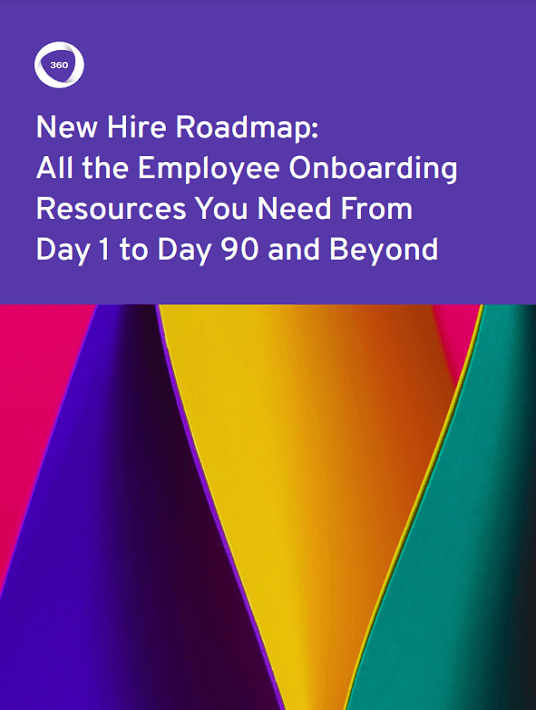The Ultimate Employee Onboarding Checklist
Our previous article covered why a structured onboarding makes such a big difference in offering personalized support for your new hires. Now, let’s get into the details: what should your new hire training look like over the first 30, 60, and 90 days? We’ve got an employee onboarding template you can use to structure your onboarding, focus on continual training, and help your new hires ramp up quickly and effectively.

1. Pre-boarding
Every great employee onboarding checklist starts with one thing: pre-boarding. This is everything that happens from contract signing to arriving at the office–or signing in for Day One from home.
Pre-boarding seldom gets the attention it deserves, but it’s a critical bridge from the sourcing and hiring process through to the onboarding process. Your new hires need to know all the details for their first few weeks, including access to email or chat systems, project management tools, key learning platforms, time tracking instructions, and anything else they’ll need to rely on from day to day.
It might sound obvious, but it bears repeating: fundamental access issues are one of the most common first-day problems for companies when onboarding new employees. Fortunately, they’re also one of the easiest to solve: simply build a pre-boarding checklist and make sure everything is covered off.
Pre-boarding isn’t only about tools and access, either– it’s also a chance to demonstrate your distinct company culture. For example, at 360Learning our pre-boarding modules include detailed guidance and information on key aspects of our Convexity culture, like our preference for asynchronous work and communication via Trello. This is a key part of our continual training culture, and helps us to troubleshoot any difficulties that may come up.
At 360Learning, Our Key Pre-Boarding Steps Include:
- Preparing physical materials, including computer and welcome kit (note: for a remote onboarding program, this would mean sending this welcome kit and equipment by post)
- Setting up new hire profiles on our systems, e.g. email, LMS, learning platforms, and other tools and software used internally
- Reviewing learning paths and resources that will be shared with the new hire to ensure everything is complete and clear
- Planning and coordinating all communications (e.g. calendar invitations) between different internal stakeholders
- Scheduling time to introduce new joiners to colleagues and team members directly
- Establishing clear channels for new joiners to provide feedback, learn more about our distinct work culture, and identify any areas of improvement in the pre-boarding process
Checking off these key pre-boarding steps will ensure your new hires get off to a flying start. With pre-boarding out of the way, it’s time to move ahead to the next stop on your employee onboarding checklist: induction.
2. Induction
Now that your new hires have arrived for their first day (or, in the case of remote onboarding, signed on for their first day), they’re ready to start their induction. This is a critical part of every employee onboarding checklist.
In contrast to role-specific onboarding, induction can be standardized for all new hires. That’s because you’re introducing your new employees to the fundamentals: presenting your product or services, showing how you create value for customers and clients, delving into your company culture in greater detail, and offering an overview of the key tools new hires will need to use.
To give you a clearer idea of how induction works, let’s run through an example. At 360Learning, we spend a day and a half on induction, with the goal of making these critical first days as engaging and positive as possible. In this first day and a half, our new hires are guided through structured learning paths that help them understand the essentials of life at 360Learning. When they open their inbox, they’ll receive an invitation to join our Day One learning program–this helps them have the smoothest possible new hire experience.
Specifically, We Split Our Induction Program Into Approximately 20 Individual Courses Covering:
- An overall introduction and welcome to the company
- An introduction to our culture and organization, including how we support our clients to embrace Collaborative Learning
- A workshop on our core Convexity values and how we live these every day
- A module on the importance of giving and receiving feedback during the onboarding process
- An introduction to our performance management and monitoring methodology
- The key tools all new hires can expect to use
During this induction phase, new hires are also introduced to the key people they can expect to accompany them on this journey:
- Coach–this is usually their line manager
- Onboarder–this is someone to assist and oversee their onboarding process
- Buddy–this is a fellow 360Learner who is there to help guide the more informal parts of onboarding
- Discovery meeting owners–these are representatives from different departments who will schedule time to explain what their teams do, and how they all fit in (more on this below)
So, that’s how we welcome all new hires with our induction process at 360Learning. How you do this will depend on your specific company culture and values, but this example can serve as a helpful template. And now, our third stage: role-specific onboarding.
3. Role-Specific Onboarding
Now that you’ve completed your employee onboarding checklist for pre-boarding and induction, it’s time to get started on the most substantial step: role-specific onboarding. At this stage, new hires start to move from common content (the basics) to the specific activities they’ll be expected to perform, and begin the process of ramping-up to their expected level of core performance.
This is the most crucial stage in the process of onboarding new employees. It’s where your new hires go beyond the fundamentals to build a deep understanding of their role, forming relationships with other individuals and teams. It’s also where they start to understand how they can add value and contribute specific expertise to shared projects. Here, it’s helpful to focus on a specific example to give you a sense of how onboarding new employees really works in practice.
At 360Learning, by the end of the second day of onboarding, our new hires will start to engage in role-specific onboarding. This means continuing their Learning Path on the 360 platform, but also working on role-specific tasks and information curated within our project management system (Trello) and our learning platform (360Learning).
Days three to five include learning a lot of new information about the different functions within the company. New hires will participate in a lot of discovery meetings with other teams, and will be gradually exposed to core tools and processes. By the end of the first week, learners will have completed a designed number of learning programs.
Now, they’ll have a clearer vision of important milestones, and will understand the skills they need to demonstrate to shift into the day-to-day requirements of their role. Their completion of the learning programs will also indicate to their coach or onboarder that they are on the right track, and that they’re committed to continual training.
Defining The First 30, 60, And 90 Days Of Employee Onboarding
Role-specific onboarding is where it becomes important to split your goals into what you expect your new hires to demonstrate in their first 30, 60, and 90 days.
The process of ramping-up happens in parallel to role-specific onboarding, and involves mastering all the fundamentals needed to undertake their core responsibilities–this part of the onboarding can last up to three months in total.
For new hires and their line managers, ramping-up means shifting to a long-term model of progression. Rather than just getting their feet under the desk, new hires should now be thinking about their personalized career journey. In some of 360Learning’s locations (for example, France), this period coincides with the end of probationary employment periods.
Be sure to build in time for regular feedback on the onboarding process, and set up performance reviews for the end of the 30, 60, and 90-day onboarding periods.
Conclusion
Download the eBook New Hire Roadmap: All The Employee Onboarding Resources You Need From Day 1 To Day 90 And Beyond to learn how to launch a new hire training program that makes a mark and fosters lifelong L&D. Also, join the webinar to stay updated with a new hire roadmap that will leverage your onboarding process!


